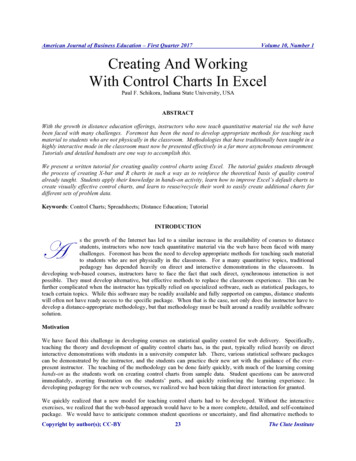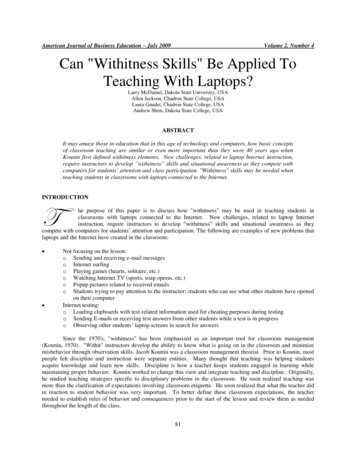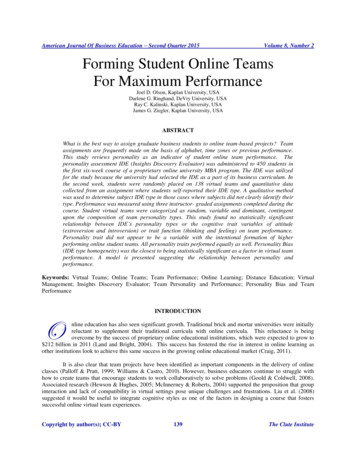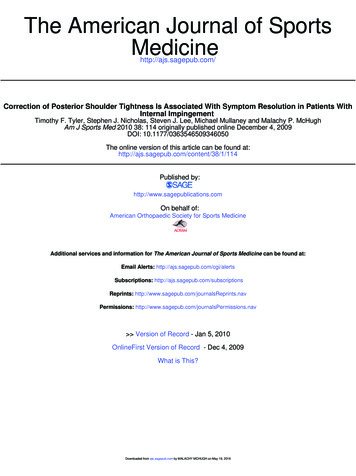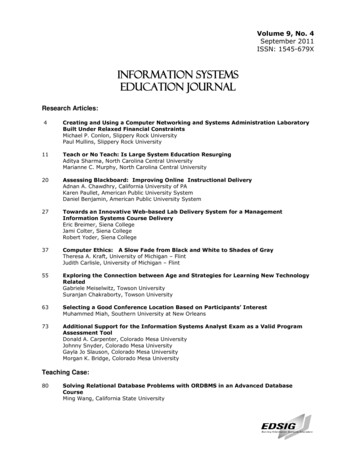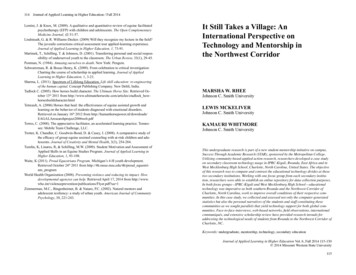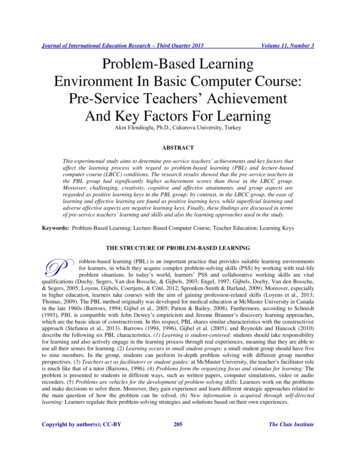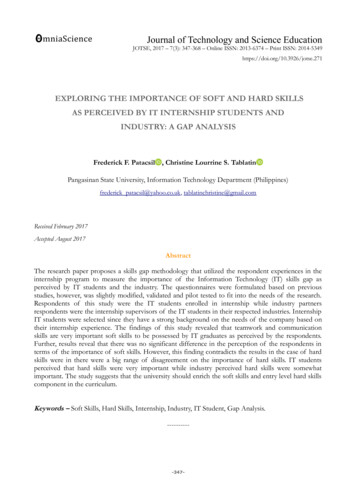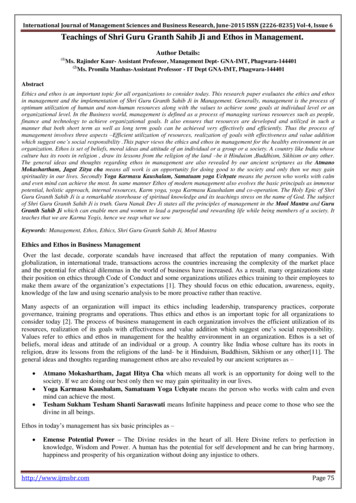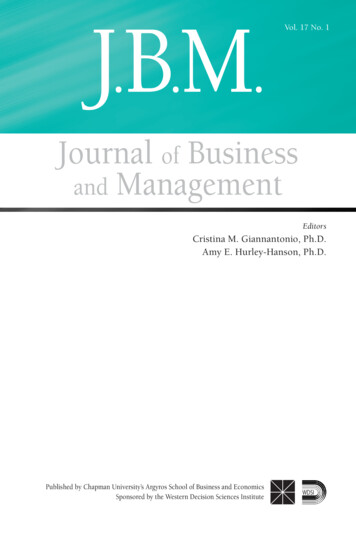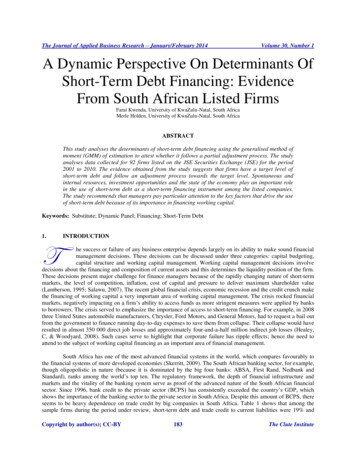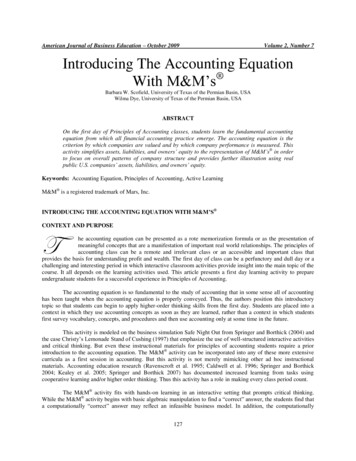
Transcription
American Journal of Business Education – October 2009Volume 2, Number 7Introducing The Accounting EquationWith M&M’s Barbara W. Scofield, University of Texas of the Permian Basin, USAWilma Dye, University of Texas of the Permian Basin, USAABSTRACTOn the first day of Principles of Accounting classes, students learn the fundamental accountingequation from which all financial accounting practice emerge. The accounting equation is thecriterion by which companies are valued and by which company performance is measured. Thisactivity simplifies assets, liabilities, and owners’ equity to the representation of M&M’s in orderto focus on overall patterns of company structure and provides further illustration using realpublic U.S. companies’ assets, liabilities, and owners’ equity.Keywords: Accounting Equation, Principles of Accounting, Active LearningM&M is a registered trademark of Mars, Inc.INTRODUCING THE ACCOUNTING EQUATION WITH M&M’S CONTEXT AND PURPOSEThe accounting equation can be presented as a rote memorization formula or as the presentation ofmeaningful concepts that are a manifestation of important real world relationships. The principles ofaccounting class can be a remote and irrelevant class or an accessible and important class thatprovides the basis for understanding profit and wealth. The first day of class can be a perfunctory and dull day or achallenging and interesting period in which interactive classroom activities provide insight into the main topic of thecourse. It all depends on the learning activities used. This article presents a first day learning activity to prepareundergraduate students for a successful experience in Principles of Accounting.The accounting equation is so fundamental to the study of accounting that in some sense all of accountinghas been taught when the accounting equation is properly conveyed. Thus, the authors position this introductorytopic so that students can begin to apply higher-order thinking skills from the first day. Students are placed into acontext in which they use accounting concepts as soon as they are learned, rather than a context in which studentsfirst survey vocabulary, concepts, and procedures and then use accounting only at some time in the future.This activity is modeled on the business simulation Safe Night Out from Springer and Borthick (2004) andthe case Christy’s Lemonade Stand of Cushing (1997) that emphasize the use of well-structured interactive activitiesand critical thinking. But even these instructional materials for principles of accounting students require a priorintroduction to the accounting equation. The M&M activity can be incorporated into any of these more extensivecurricula as a first session in accounting. But this activity is not merely mimicking other ad hoc instructionalmaterials. Accounting education research (Ravenscroft et al. 1995; Caldwell et al. 1996; Springer and Borthick2004; Kealey et al. 2005; Springer and Borthick 2007) has documented increased learning from tasks usingcooperative learning and/or higher order thinking. Thus this activity has a role in making every class period count.The M&M activity fits with hands-on learning in an interactive setting that prompts critical thinking.While the M&M activity begins with basic algebraic manipulation to find a “correct” answer, the students find thata computationally “correct” answer may reflect an infeasible business model. In addition, the computationally127
American Journal of Business Education – October 2009Volume 2, Number 7“correct” answers have importance as measures that describe an organic entity incorporating both risk and reward.Thus, the numerical answer is a means to an end, rather than an end in itself.The M&M activity takes advantage of the random nature of the contents of M&M snack packs so thateach student creates three unique cases to use in exploring the accounting equation. Furthermore, when in a smallgroup, students have unique examples on which to base their contribution, encouraging active participation andcreating positive interdependence. As a first day of class activity, it also begins building student-to-studentconnections that can be used in later classes to facilitate developing team skills. When the students work together,they compare and contrast three to four instances of each equation, and are likely to find the puzzling cases ofnegative equity and negative liabilities.LEARNING OBJECTIVESThe M&M activity has the following learning objectives: Students will be able to state the accounting equation accurately.Students will be able to use the accounting equation to solve for missing information about a company.Students will understand the meaning of negative owners’ equity.Students will be able to use the accounting equation to understand the capital structure of a company andthe variety of uses of debt in a business.Students will be able to use the accounting equation to understand the business risk in companies.THE M&M ACTIVITYThe M&M Activity presents the fundamental accounting equation in two phases: a hands-on activityusing M&M’s to organize discussion of the accounting equation followed by an illustration of the same accountingequation concepts using real company financial information.The hands-on activity includes the four parts: (1) Individual student solutions using the accounting equationand M&M’s ; (2) Class discussion of solving for assets using the accounting equation; (3) Small group discussion ofsolving for equity and liabilities; (4) Class discussion providing a wrap-up from the small groups.The hands-on activity begins by providing students an M&M snack pack and a handout titled Introducingthe Accounting Equation with M&M’s (see Appendix). Students are directed to sort the M&Ms by color into thesimilarly colored circles on the handout. They then record the number M&M’s in each colored circle and solve forthe missing information in each equation. This initial task promotes immediate success and some fun. The mostcommon instructor help needed by students is to caution students to be accurate about the sign of the numbersinvolved and to reassure students that “0” can be used when a snack pack includes only five of the six colors, asoccasionally occurs.The M&M activity continues with a review by the whole class of the most straight-forward accountingequation example: solving for assets when liabilities and owners’ equity are known. Typical instructor-leddiscussion includes the following questions: Can this equation describe a business’s financial position? Support your decision.Describe the risk of a business with your sample financial position.Follow-up questions include: How many students have more liabilities than owners’ equity in your Square-Blue-Red Equation? Is thispossible? Is this desirable? How does a company get more liabilities than owners’ equity?How many students have more owners’ equity than liabilities? Is this possible? Is this desirable? How doesa company get more owners’ equity than liabilities?128
American Journal of Business Education – October 2009Volume 2, Number 7Student responses create a list of different M&M -based capital structures, all of which are feasible. Fromthese examples, students begin to understand that companies can have any combination of liabilities and owners’equity funding their assets. More sophisticated students may point out liabilities from environmental or legalcontingencies or pension agreements that also result in companies having large liability burdens, apart from debt.The instructor can provide additional insight about the relationship between capital structure and company’sstrategic choices. Students readily understand that liabilities require future cash outflows and thus increase financialrisk. However instructors can also explain that more liabilities may be a company choice consistent with itsunderlying business strategy rather than simply a sign of poor performance. On the equity side, instructors candiscuss that equity comes from earnings or investment by owners. Thus, when equity is smaller than liabilities, thecompany may be unprofitable and/or unable to raise equity from owners.Once the students are familiar with one instance of using the accounting equation, they are directed todiscuss the remaining two (solving for liabilities and solving for equities) in small groups of three to four students.The groups discuss the following questions: Can each equation describe a business’s financial position? Support your decision.Describe the risk of a business with your specific financial position.Commonly, students ask for confirmation of negative equity and/or negative “liability” amounts that agroup member reports to the group. The author recommends encouraging the students to consider the implications ofthese results without giving definitive answers. When the groups have had time to share their individual results, theinstructor again leads a whole class discussion.When groups report on their solving for owners’ equity, students realize that negative owners’ equity iscertainly possible. Typical instructor-led class questions are the following: How many students have examples with positive owners’ equity? Is this possible? Is this desirable? Whendoes a company have positive owners’ equity?How many students have examples of negative owners’ equity? Is this possible? Is this desirable? Whendoes a company have negative owners’ equity?Students often assume that negative equity as a sign of both poor performance and high risk. Whilenegative equity is clearly undesirable, instructors can explain to students that businesses can operate with negativeequity, and rapidly growing, innovative companies may be valued despite their negative equity. Furthermore,positive owners’ equity can result from either contributions by owners or profitable operations. So companies thatare otherwise unprofitable can still have positive equity given sufficient contribution by owners, as when a companyis first founded.In the last accounting equation example, students report on their use of the accounting equation to solve forliabilities. Students realize that, although one can create a scenario in which that is negative liabilitiesmathematically, this cannot be an actual business situation. Typical instructor-led discussion questions are thefollowing: How many students have examples with negative liabilities? Is this possible? Is this desirable? When doesa company have negative liabilities?How many students have examples with positive liabilities? Is this possible? Is this desirable? When does acompany have positive liabilities?Instructors can explain to students that negative liabilities would only occur if a company overpaid itscreditors. But even then, overpaid liabilities would result in an asset – money owed to the company – rather than anegative liability. In addition, instructors can help students understand that some level of liabilities are unavoidablefor any company because of normal business-to-business, business-to-employee, and business-to-customertransactions in which goods or services are obtained before paying for them. Accounts payable to suppliers, thereceipt of payment before providing services to customers, as in the airline industry, or longer-term compensated129
American Journal of Business Education – October 2009Volume 2, Number 7absences payable (vacation pay) or pension payable may exist even when a company has never borrowed anymoney.After completing the handout Introducing the Accounting Equation with M&M’s , students eat theirM&M’s , and the second phase of the M&M Activity is begun. Three different sets of company financialinformation are used to relate the actual financial structures of real companies to the patterns that the students havefound using M&M’s : (1) A comparison of Delta Airlines, Southwest Airlines, and AMR, the parent company ofAmerican Airlines; (2) A comparison of the changing leverage of Amazon.com through time; and (3) A comparisonof the capital structure of Microsoft through time. The first set of information using real companies compares airlines, since this industry includes companiesthat differ in their use of leverage. Instructors use the following questions to encourage students to identify thedifference in performance and risk among Southwest Airlines, Delta Airlines, and AMR. Do all airlines have the same relationship of liabilities and assets?Which airline has negative owners’ equity?How can all three airlines continue to provide air flight services to customers?Which airline is the riskiest financially?Figure 1: Accounting Equation for Selected Airlines in 2008Students should be able to read the presence of negative equity for American Airlines, the small amount ofpositive equity of Delta Airlines, and the much more balanced profile of Southwest Airlines based on the assets andliabilities provided. American Airlines is an example of a company with negative equity that continues to operate.However, in this case, students are likely to know that American Airlines has had financial distress and that Deltaemerged from bankruptcy in 2006. The additional information about Net Income in Table 1 can be used byinstructors to give students additional information to explain the common downturn, but different paths of Delta,American Airlines, and Southwest Airlines post 9/11.The second set used is a comparison of financial information for a single company through time toencourage students to identify the differences in performance and risk as a company develops and grows. In Figure2, Amazon.com provides a familiar example to illustrate this point. Instructors use the following questions:130
American Journal of Business Education – October 2009 Volume 2, Number 7How does this company’s relationship of assets to liabilities change through time?What do you think accounts for this change?Figure 2: Accounting Equation for Amazon.com 1997
American Journal of Business Education – October 2009 Volume 2, Number 7 127 Introducing The Accounting Equation . of the capital structure of Microsoft through time. The first set of information using real companies compares airlines, since this industry includes companies that differ in their use of leverage. Instructors use the following questions to encourage students to identify the .
